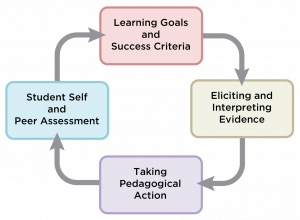Learning Modules
Our teacher learning modules and assessment-focused communities include videos and links to research, briefs, and worksheets from our Resource Hub.
Formative Assessment In Action
The Formative Assessment in Action Spotlight aims to provide educators with resources that support learning about the formative assessment process. The spotlight includes one-page excerpts highlighting key ideas in formative assessment, classroom videos that showcase formative assessment in action, and opportunities to deepen learning about formative assessment. Educators can use the opportunities to analyze others’ practice with an eye towards incorporating new learning into current instructional routines.
Learning about the Formative Assessment Process

Video Practice with Formative Assessment
Below are two spotlight sections containing videos about Formative Assessment in Action. The section, Examples of the Elements in Action, showcases video examples of each formative assessment element implemented effectively in the lessons. The next section, Time to Investigate, includes opportunities to review several videos and analyze how each teacher integrates the formative assessment elements into her classroom practice. For every video, there is a brief summary of the content, plus a link to its Video Viewing Protocol. The protocol includes information about the teacher’s practice in relation to each element. These are not all encompassing descriptions. They offer a few observations about teacher and student actions intended to provide the seeds for thought and discussion. In each protocol, you can write down notes, including general observations and specific commendations/suggestions. If you’d like more information about formative assessment before you get into the videos, check out the descriptions of the formative assessment elements below.
Please note that on January 1st, 2020, the Teaching Channel switched to a subscription service for their content. CSAA is working to identify high-quality, publicly available alternatives to the Teaching Channel videos included in this Spotlight.
1. Examples of the Elements in Action
Watch these videos first. You will see examples of the elements being implemented effectively in a classroom situation. Using the Video Viewing Protocol for each one will deepen your understanding of each element.
2. Time to Investigate
Continue with this spotlight section, where you will have the opportunity to review several videos and analyze the teachers’ formative assessment practice. Again, completing each Video Viewing Protocol will help you gain a better insight into the formative assessment process.
